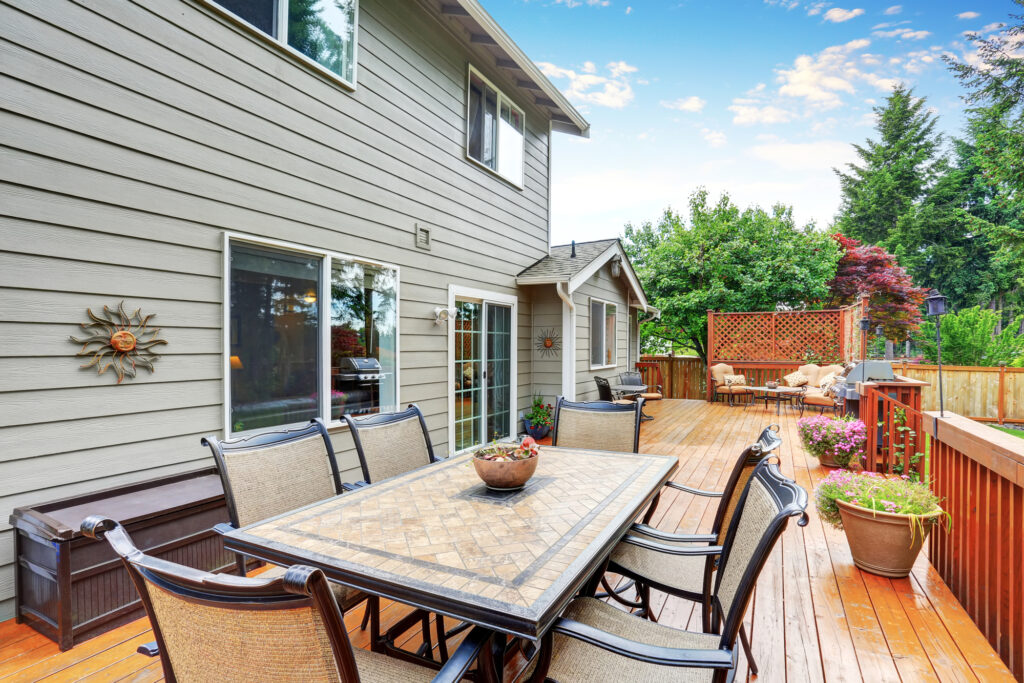
Regarding outdoor living spaces, decks and patios are both popular options for homeowners. They provide a great way to extend your living space and create an area for entertainment, relaxation, and enjoyment of the outdoors. However, choosing between a deck and a patio can be a tough decision. Each has its own unique features, benefits, and considerations that may impact your decision. Here are the key differences between decks and patios to help you determine which option is better for your home.
Definition and Construction
Let’s start by understanding the basic definitions of a deck and a patio. A deck is an elevated platform made of wood or composite materials that is attached to the house, typically supported by posts and beams. It is often built off the back of the house and can be accessed from indoors. On the other hand, a patio is a paved outdoor area that is at ground level, usually made of concrete, stone, or brick. It can be attached to the house or built as a free-standing structure in the backyard.
The construction process for a deck and a patio also differs. Building a deck requires a more extensive and complex process. It involves excavation, pouring footings, setting posts, and constructing a frame. The deck boards are then attached to the frame, followed by railing installation. Building a patio, on the other hand, is a simpler process. It typically involves preparing the area by leveling the ground, laying a base of compacted gravel, and then installing the chosen paving material, such as concrete or stone. In terms of construction difficulty, decks require more expertise and time, while patios are relatively easier and faster to build.
Cost Considerations
One of the most important factors in deciding between a deck and a patio is cost. The overall cost can vary depending on materials, size, design complexity, and any additional features. Generally, decks tend to be more expensive than patios due to the additional materials required for construction. Decks require structural framing, support posts, and railing, while patios only need the paving material and a base. The cost of decking materials like wood or composite can also be higher than the cost of concrete or pavers used for patios.
Maintaining a deck can also be more costly in the long run. The wooden parts of a deck need regular maintenance, including staining, sealing, and protecting against weather damage and termites. Composite deck materials, while more expensive upfront, require less maintenance but may still need periodic cleaning and checking for any signs of wear and tear. In contrast, patios made of concrete or other durable materials require less maintenance. Regular cleaning and occasional sealing are usually sufficient to keep a patio in good condition.
Durability and Longevity
When it comes to durability and longevity, decks and patios have their own advantages and considerations. Decks made of natural wood can be susceptible to rotting, warping, and insect damage. However, with proper maintenance and treatment, they can last for several decades. On the other hand, decks made of composite materials offer better resistance to weathering, fading, and insect damage. Composite decks have a longer lifespan and generally come with extended warranties.
Patios made of concrete, stone, or brick are known for their durability. The said materials are resistant to weather effects, including freezing and thawing. Properly installed and maintained, a patio can last for decades and even a lifetime. However, it is worth noting that concrete may crack over time, while stone or brick may shift or settle. Regular maintenance and repairs may be required to keep a patio in good condition. Still, overall, patios require less maintenance than decks.
Design and Aesthetics
Another important aspect to consider is the design and aesthetics of your outdoor space. Decks offer more design flexibility and can be customized to match the style and architectural elements of your home. With a deck, you have the option to choose from different materials, colors, and finishes to create the desired look. You can also incorporate different levels, built-in seating, or even multi-story structures to maximize your outdoor living space. Decks can be an excellent choice for homes with a view or uneven terrain, as they can be built at different heights to accommodate the topography.
Read: 7 Deck and Patio Ideas for Your Home
On the other hand, while patios may have limited design options, they can still offer a visually appealing outdoor space. For example, patios made of natural stone can provide a rustic and elegant look that complements various architectural styles. Patios also offer a seamless connection between indoor and outdoor living spaces, especially if they are built directly off the house. Adding features like pergolas, fire pits, or outdoor kitchens can further enhance the aesthetics and functionality of a patio.
Versatility and Functionality
When it comes to versatility and functionality, both decks and patios have their unique advantages. Decks are a great option for home addition that require elevation or have uneven terrain. They provide an elevated space that can offer panoramic views, privacy, and additional usable space. Decks are also ideal for accommodating features like hot tubs, swimming pools, and outdoor kitchens. The elevation of a deck can create a more intimate setting and provide a sense of separation from the rest of the outdoor space.
On the other hand, patios are more versatile in terms of use and can be easily adapted to different purposes. They can be designed to accommodate outdoor furniture, seating areas, dining spaces, and even recreational activities like basketball or tennis courts. Patios are also more accessible for people with mobility issues or those who prefer a space that is at ground level. Additionally, patios can be easily expanded or modified, making them a flexible choice for homeowners who may want to change or extend their outdoor living space in the future.
Climate Considerations
Considering your climate is crucial when deciding between a deck and a patio. The climate in your area can influence the comfort and usability of your outdoor space throughout the year. Decks made of wood can be affected by extreme weather conditions such as excessive heat or moisture. Wood can expand and contract under different temperatures, potentially causing warping or cracking. Additionally, wood can become slippery when wet, posing a safety hazard.
In contrast, patios made of materials like concrete or stone are more resistant to temperature fluctuations. They can handle exposure to direct sunlight without damage and are less prone to become slippery when wet. Patios also provide a cooler surface to walk on during hot summer days. However, it is crucial to consider the local climate carefully when choosing the paving material for a patio. Certain types of stones or pavers may absorb heat and become uncomfortable to walk on in hot climates.
Noise and Privacy
Noise and privacy considerations may also influence your decision between a deck and a patio. Decks, especially when elevated, can offer better views and privacy if strategically positioned. The added height can help to create a barrier between your outdoor space and neighboring properties. However, it is worth noting that decks can also amplify noise, especially if they are located close to busy roads or noisy areas.
Patios, on the other hand, are generally located at ground level and do not provide the same level of elevation or privacy. They may require additional elements like walls, fences, or landscaping to create a more secluded outdoor space. However, when surrounded by trees or shrubs, patios can offer a sense of tranquility and privacy.
Local Regulations and HOA Restrictions
Finally, it is important to consider any local regulations or homeowner association (HOA) restrictions that may impact your decision. Some areas may have building codes or permits required for the construction of decks or patios. You should check with your local authorities to ensure that you comply with any necessary permits or regulations.
If you live in a neighborhood with an HOA, there may be specific rules and guidelines regarding the construction, design, and placement of outdoor living spaces. Some HOAs may have restrictions on the materials, colors, or height of decks, while others may have limitations on the paving materials or the overall size of patios. It is essential to review your HOA guidelines and obtain any necessary approvals before proceeding with the construction of a deck or patio.
Read: Deck and Patio Remodeling: Mistakes to Avoid
Choosing between a deck and a patio for your home requires careful evaluation of several factors, including your budget, lifestyle, climate, design preferences, and local regulations. Decks offer greater design flexibility, customization options, and elevated views, while patios provide easier maintenance, durability, and versatility in use. Your decision can also be influenced by factors such as cost, maintenance, privacy, noise considerations, and the specific requirements of your home and outdoor space.
Ultimately, the best choice for home addition will depend on your individual needs, preferences, and circumstances. If you are looking for an elevated space with panoramic views or have uneven terrain, a deck may be the better option. However, if you prefer a lower-maintenance and more versatile outdoor space that seamlessly connects with your indoor living areas, a patio may be the better choice. By considering all these factors and comparing the pros and cons, you can make an informed decision that will enhance your outdoor living experience and add value to your home.
